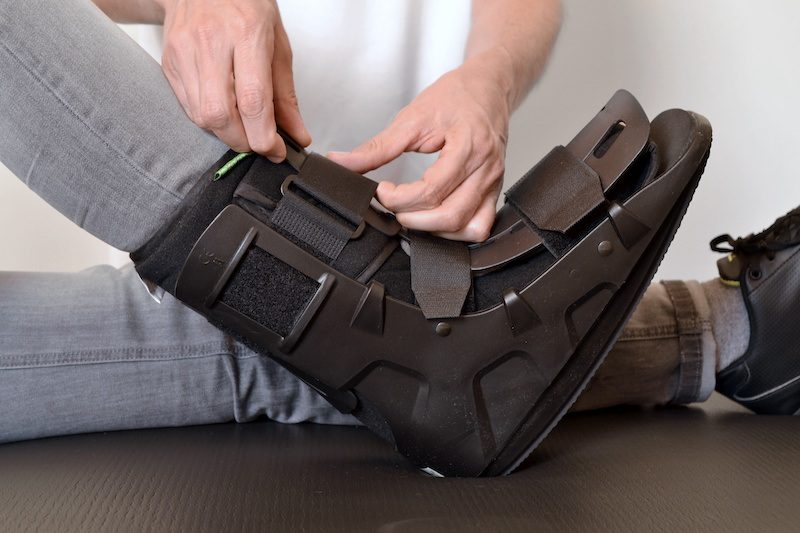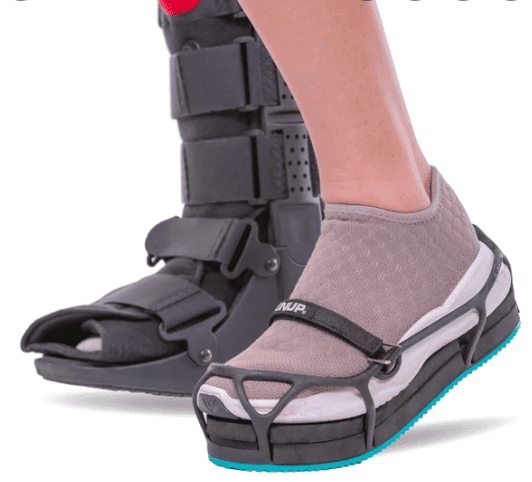
Jump to section
Often referred to as a moon boot, a CAM walker is a device that helps keep the foot and ankle in a controlled and supported position - hence the acronym ‘Controlled Ankle Motion’. It replaces your shoe on the foot you wear it on, and is considered gold standard in the treatment of numerous lower limb injuries.
There are a number of types of walkers available depending on your needs. Some use thick, selective padding, and others use a pneumatic pump and other technologies to secure and protect the leg, ankle and foot.
CAM walkers are typically used for serious injuries to the foot or ankle where the weight and stress to the damaged area needs to be at least partially removed in order to create an ideal environment for healing and repair. Often, without the use of the boot, the injury may progress and worsen, leading to increased pain, frustration and a longer healing time.
What our patients love about moon boots is that compared to the plaster cast alternative, moon boots are:
Across our Brisbane clinics, the most common injuries where we use moon boots as part of the treatment include:
Moon boots are not a standalone treatment, but often important in the early stages. Once healing progresses and you’re out of the ‘risk zone’ for further injury, you can move back into a comfortable and supportive pair of joggers, potentially with custom foot orthotics, to continue the rest of your rehabilitation.
During your appointment, your podiatrist will select the best type of moon boot for you depending on your diagnosis and the nature of your injury, your foot size, your leg shape, the height of the boot required, and other factors. Your foot will be positioned inside the boot, where your podiatrist will teach you how to take them on and off. The boot will be securely fastened, and the level of support and your gait will be checked. For your opposite leg, we have the even up shoe lift that levels you up so you find it easier to walk and don’t get any lower back, hip or knee pain from the uneven leg height.
In some cases, your condition may benefit best from having foot orthotics inside your boot. If that’s the case, we’ll advise you during your appointment.
Once your moon boot is fitted, every time you take a step on the foot with the boot, it will be working to offload pressure and strain from the vulnerable injury site. This means that your healing and repair process can stay on track, as opposed to being set backwards from high loads causing further damage and delaying your healing, with each step.
Moon boots are best worn from the moment we receive your diagnosis and see that it clinically indicates the use of a moon boot for best results, until sufficient healing has occurred that we can be confident that wearing other shoes won’t cause you further damage. The way we assess when this point has been reached is usually through repeated medical imaging (xray, ultrasound) to check the progress. We will let you know as soon as it is safe to discontinue wearing your moon boot. For our patients, this usually takes between 4-8 weeks, but can be longer if progress is being made slowly or periods of accidentally not wearing the boot has caused further damage.
It’s important to wear your boot any time that you are walking or standing. You can remove your boot during sleeping and when showering (taking care not to overload the injured foot), but ideally for the rest of the time, your foot will stay supported in your boot.
Wearing a moon boot can increase your risk of deep vein thrombosis - a blood clot in a vein. This is as one of the main causes of DVT is limited mobility. If you notice growing pain, cramping, throbbing, swelling or warmth in your foot or leg, seek urgent medical care.
You must also take extreme care when managing stairs due to the restricted ankle motion. Always hold onto the railing and lead with the foot that is not in the boot when going up the stairs, and lead with the foot in the CAM walker when going down the stairs. We also recommend that if you use a one-sided bag, switching to a backpack to evenly distribute weight over your body, as your balance may be impaired with the boot. Never drive with the boot on your brake or accelerator foot.
Depending on the type of device you have, the inner liner is typically removable and can be washed and air dried. The outer plastic shell can be cleaned using a damp cloth. Ensure the boot is completely dry before wearing again - ideally have a family member wash it before bed, and return it to you by the morning.
FAQ
Should I restrict the amount of walking I do while in a moon boot?
As long as you’re walking carefully and safely, you can continue to walk normally. In fact, walking can help promote blood flow to the feet to help maintain optimum recovery conditions.
Are moon boots comfy?
Given that the role of the walker is to offload a damaged and painful area, it will actually be more comfortable compared to walking directly on the injured foot. The lining is supportive, so it is comfortable, but it does take an adjustment period to get used to it as it does feel very different to walking in a regular shoe. Additionally, comfort can also be improved with the even up shoe on the other foot.

Is there anything else I can be doing to speed up my recovery?
Wearing the boot any time you’re walking is one of the best things you can be doing in the early stages of your recovery. We will also recommend specific foot and ankle exercises as appropriate, plus we may use our new MLS laser to help speed up the recovery process.
Once sufficient repair has occurred while wearing your boot, your podiatrist will begin other stages of your treatment to help you get the best results. If there’s anything else you can be doing in your unique circumstances, we’ll always let you know.
Are you a registered NDIS provider?
Absolutely. Under NDIS we can offer you a range of devices such as custom foot orthotics, AFOs and custom braces under the assistive technology support. For many people, this greatly improves their mobility, independence and quality of life.
| Monday | 7:40am - 6:00pm |
| Tuesday | 7:40am - 6:00pm |
| Wednesday | 7:40am - 6:00pm |
| Thursday |
7:40am - 6:00pm |
| Friday | TEMP CLOSED |
| Saturday | CLOSED |
| Sunday | CLOSED |
Ground Floor, 344 Queen Street,
Brisbane City QLD 4000
| Monday | 7:40am - 6:00pm |
| Tuesday | 7:40am - 6:00pm |
| Wednesday | 7:40am - 6:00pm |
| Thursday |
7:40am - 6:30pm |
| Friday | 7:40am - 5:00pm |
| Saturday | 7:40am - 4:30pm |
| Sunday | CLOSED |
Newmarket Village, 114/400 Newmarket Rd, Newmarket QLD 4051